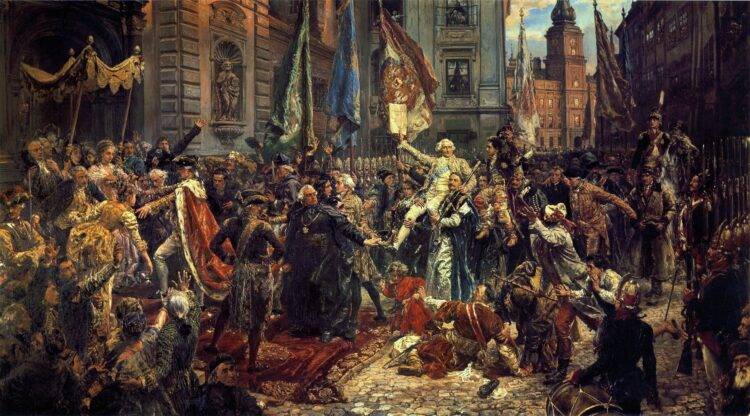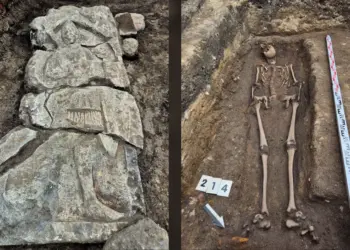The 3rd of May marks a monumental day in Polish history and, indeed, the annals of world democracy. On this day in 1791, Poland adopted the Constitution of May 3rd, becoming the first nation in Europe and the second in the world, after the United States, to formalize a written national constitution. This historic document not only symbolized a forward-thinking era in Polish governance but also a beacon of hope that has endured through the nation’s most turbulent times. This blog post delves deep into the origins of the May 3rd Constitution, its profound implications, the tragic aftermath, and why its commemoration remains a cornerstone of Polish national identity today.
- More News from Poland on our Homepage.
- Sign up to our Newsletter
The late 18th century was a period of significant enlightenment and reform across Europe, and the Polish-Lithuanian Commonwealth was no exception. By the 1780s, the Commonwealth had been significantly weakened by internal conflicts and external influences from neighboring powers such as Prussia, Austria, and Russia. The need for substantial reform was evident to safeguard Polish sovereignty and revitalize its political system.
Amid these pressures, the Four-Year Sejm, a parliamentary assembly, convened in 1788, led by prominent reformers like King Stanisław II August, Ignacy Potocki, and Hugo Kołłątaj. The debates and discussions focused on strengthening the nation through enhanced royal powers, increased rights for the peasantry, and the creation of a modern, centralized government. These progressive ideas culminated in the drafting and adoption of the Constitution on May 3, 1791.
The Constitution of May 3rd: A Trailblazing Document
The Constitution of May 3rd was revolutionary for several reasons. It transferred much of the political power from the nobility to the monarch, creating a constitutional monarchy that was quite progressive for its time. It aimed to improve the lot of the peasantry, reduce the systemic imbalances in Polish society, and protect the Polish-Lithuanian Commonwealth from further foreign manipulation and partition. The Constitution also emphasized the separation of powers within the government, a novel concept in European governance at the time, inspired by the same enlightenment principles that had influenced the United States Constitution.
Despite its progressive nature, the Constitution was met with opposition from factions within the nobility who felt threatened by the shift in power and from neighboring countries that saw a strong Poland as a threat to their interests. This opposition eventually led to the Constitution’s downfall and the second and third partitions of Poland in the 1790s, which wiped Poland off the map of Europe for over 123 years.
The Aftermath and the Struggle for Independence
The adoption of the Constitution and the subsequent partitions ignited a series of uprisings and a profound sense of national identity among Poles. Although the Constitution was in effect for barely a year, it became a symbol of the ideal of Polish independence. Throughout the 19th century, as Poland struggled under the yoke of partition and occupation, the memory of the May 3rd Constitution inspired numerous national uprisings and a sustained struggle for sovereignty and self-determination.
The spirit of the May 3rd Constitution kept the hope for independence alive among generations of Poles. Even as they faced oppression under the partitions and later struggles, including World War II and the Soviet influence during the Cold War, the ideals of the Constitution remained a touchstone for Polish cultural and political identity.
Celebrations Banned Under the Communist Regime
During the communist era in Poland, the celebration of the May 3rd Constitution was banned. The communist regime, established post-World War II and heavily influenced by Soviet Russia, viewed the Constitution as a symbol of nationalism and bourgeois ideology, which contradicted the communist doctrines of internationalism and proletarian unity. Despite the ban, the Polish people continued to honor the day in subdued and often covert celebrations, which helped to keep the flame of national pride and the desire for sovereignty burning.
Since the fall of communism in 1989, May 3rd has been reinstated as a national holiday and is celebrated with great enthusiasm across Poland. It is a day of pride, reflection, and joyous celebration, featuring parades, speeches, concerts, and public readings of the Constitution. The day serves as a reminder of Poland’s resilience, the enduring quest for freedom, and the importance of democracy and rule of law.
Today, the Constitution of May 3rd is more than just a historical document; it is a symbol of the enduring Polish spirit. Its celebration every year is a reaffirmation of the values that have defined Poland’s past and continue to shape its future. It reminds not only Poles but also the global community of the power of constitutionalism and the unyielding human spirit


















